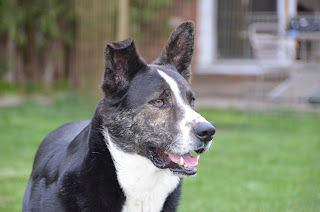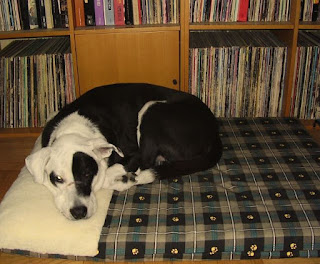dogs, apartments, and anxiety: in which diego returns to school
As I mentioned (almost a month ago now), our pack of four is moving to a new den. We're going to stop renting houses, as we have done for the past ten years, and move back to apartment life. Although I've adjusted to the idea, I'm no happier about it. I'm heartsick that we'll no longer have the private oasis of a backyard.
We've found a great apartment: three bedrooms, two bathrooms, well-maintained building, lots of green space outside, dog-friendly building (it's the law in Ontario, but not always followed or enforced), good location for both driving and transit. Honestly, had I seen this apartment when I lived in New York, I would have considered it luxury. Now it just makes me sad.
But there's another factor involved in this move, a big, drooling, barking factor named Diego.
In our old house, before the flood, we were working with Diego on better on-leash behaviour, especially his reactions to other dogs. Off-leash at the dog park, Diego is playful and well socialized; on the leash, a barking, pulling maniac.
This is a common issue. We were working with a trainer when the flood upended our lives. We ended up moving, and we never resumed training. This meant I stopped walking Diego, except when the four of us walk together, and Allan can take the big boy while I walk Tala. I couldn't manage him at all.
As soon as we realized we were moving to an apartment, in a building full of dogs, I knew we needed to re-boot Diego's education.
The amazing trainer we had been working with has moved out of the area, but we are working with her by email, phone, and video. We've got a fridge full of Rollover, something this trainer turned us on to: a training treat that is nutritionally balanced, and can substitute for your dog's regular food. We're using a complicated harness-Gentle Leader-collar combination that gives me maximum control, and produces a calming effect on the dog. And we're working daily in our neighbourhood.
Diego has already made a lot of progress. It's hard for me to imagine him walking calmly past another dog we might encounter in the lobby, or not going nuts if the elevator door opens and a dog appears, but every walk is a training opportunity, and we'll just keep at it.
And there will be plenty of opportunity! We'll have to walk Tala and Diego separately for the foreseeable future, and we're on the 19th floor of a 20-story building.
But wait, there's more. There's yet another factor at play: my own anxiety. Many years ago in New York, we had a very bad experience with Buster, our pit-mix rescue who had severe fear-aggression to other dogs. This resulted in many things, including a four-day hospital stay for Allan, a famous animal behaviourist donating time to us, and a pitbull on Prozac.
And it resulted in one more thing. Walking Buster became a source of great fear and anxiety for me... which is how I learned more about post-traumatic stress syndrome. Apparently once a person has experienced a state of extreme emergency, their neural pathways are permanently changed. The threshold to trigger the fight-or-flight response is much lower. So I'd wake up in a state of anxiety, just before I had to walk the dogs. Buster and I both needed medication to go on walks! (If only he could have understood rationally. Buster was a dog of extreme obedience - a soldier who lived to follow orders. If he could have controlled himself to please us, he would have done so in a heartbeat.)
And here we are, 15 years later. It's a different dog, who is not an emotionally damaged abuse survivor, but a part of my brain doesn't know that. Dogs, of course, sense your anxiety and react to it. If their person is fearful, there must be something to be fearful and vigilant about. So Diego has to calm down for me, and I have to calm down for him.
We've found a great apartment: three bedrooms, two bathrooms, well-maintained building, lots of green space outside, dog-friendly building (it's the law in Ontario, but not always followed or enforced), good location for both driving and transit. Honestly, had I seen this apartment when I lived in New York, I would have considered it luxury. Now it just makes me sad.
But there's another factor involved in this move, a big, drooling, barking factor named Diego.
 |
| Drooly Boy |
This is a common issue. We were working with a trainer when the flood upended our lives. We ended up moving, and we never resumed training. This meant I stopped walking Diego, except when the four of us walk together, and Allan can take the big boy while I walk Tala. I couldn't manage him at all.
As soon as we realized we were moving to an apartment, in a building full of dogs, I knew we needed to re-boot Diego's education.
The amazing trainer we had been working with has moved out of the area, but we are working with her by email, phone, and video. We've got a fridge full of Rollover, something this trainer turned us on to: a training treat that is nutritionally balanced, and can substitute for your dog's regular food. We're using a complicated harness-Gentle Leader-collar combination that gives me maximum control, and produces a calming effect on the dog. And we're working daily in our neighbourhood.
 |
| Buster posing with some antiquated technology |
And there will be plenty of opportunity! We'll have to walk Tala and Diego separately for the foreseeable future, and we're on the 19th floor of a 20-story building.
But wait, there's more. There's yet another factor at play: my own anxiety. Many years ago in New York, we had a very bad experience with Buster, our pit-mix rescue who had severe fear-aggression to other dogs. This resulted in many things, including a four-day hospital stay for Allan, a famous animal behaviourist donating time to us, and a pitbull on Prozac.
And it resulted in one more thing. Walking Buster became a source of great fear and anxiety for me... which is how I learned more about post-traumatic stress syndrome. Apparently once a person has experienced a state of extreme emergency, their neural pathways are permanently changed. The threshold to trigger the fight-or-flight response is much lower. So I'd wake up in a state of anxiety, just before I had to walk the dogs. Buster and I both needed medication to go on walks! (If only he could have understood rationally. Buster was a dog of extreme obedience - a soldier who lived to follow orders. If he could have controlled himself to please us, he would have done so in a heartbeat.)
 |
| Whoever thought she'd be the calm one! |

Comments
Post a Comment